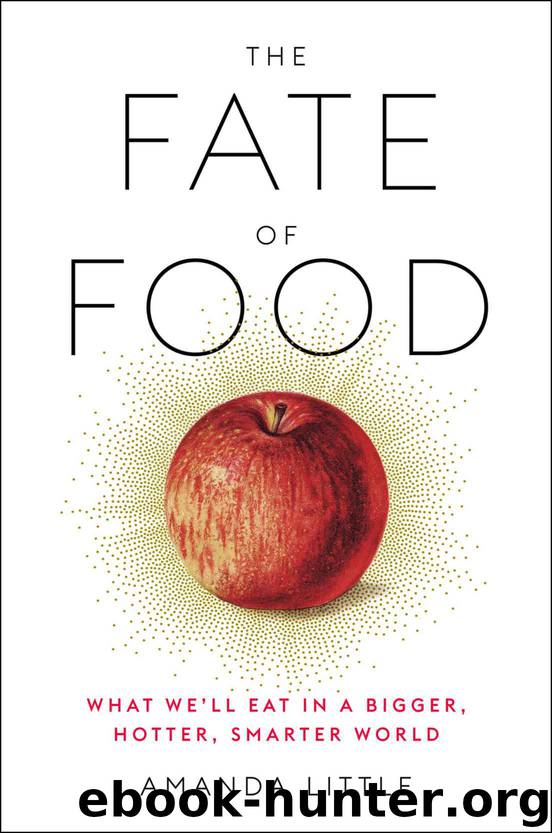The Fate of Food by Amanda Little

Author:Amanda Little [Little, Amanda]
Language: eng
Format: azw3, epub
Publisher: Potter/Ten Speed/Harmony/Rodale
Published: 2019-06-03T16:00:00+00:00
Six strains of phototrophic algae with names like Nannochloropsis gaditana, Tetraselmis chui, and Phaeodactylum tricornutum are growing inside the tubes. The lab is located next to the oil refinery because it’s siphoning carbon dioxide, a key ingredient that the algae need to grow. CO2 is captured in the oil-refining process and piped into the laboratory, bubbling into the glass tubes. The CO2 combined with sunlight fuels the algae growth. Algae are, you might say, the OG of the aquatic food chain. Aarskog believes these tiny microscopic plants that, millions of years ago, were among the first living organisms to grow on planet earth now hold a key to sustaining aquaculture.
Øyvind Oaland, Aarskog’s global director for research and development, oversees this laboratory. He’s a lean, balding man with a tidy gray goatee and thick-framed glasses. Among his many R&D challenges, the one that fascinates him most, he says, is devising strategies to convert carnivorous fish to a vegetarian diet. “Salmon are fish eaters, but they don’t require fish per se to succeed,” he tells me. “They require the nutrients and fats in those fish. If we can derive those same nutrients and fats entirely from plant sources, that changes the game.”
Vegetarian salmon feed would liberate aquaculture from dependence on wild fisheries, which are prone to collapse. Fish farmers have been getting much more efficient in the amount of fish they put into salmon feed. As a teenager, when Aarskog was dumping sardines and herring into the wooden tanks, the salmon ate as much as six times their weight in wild fish. In the 1980s, salmon farmers began to transition to manufactured feed pellets, which meant that marine ingredients in the fish feed could be mixed with plant-based ingredients. This brought down operating costs and fueled the growth of aquaculture. The pellets were less prone to spoiling, could be stored over long periods, and were easier to distribute to large cages of fish.
Marine Harvest’s fish feed division is now responsible for more than a third of the company’s total revenue. The pellets, which are fine for human consumption (I ate one and it tasted like a moldy sneaker, but nothing bad happened), are made with about 75 percent terrestrial grains (corn, wheat, soy), 20 percent fish meal (ground-up fish, mostly from the heads, tails, and bones that are cut from packaged fillets), and 5 percent fish oils. Despite consumer concerns about fish eating terrestrial grains (what self-respecting salmon would eat corn?), aquatic veterinarians say that biologically it makes no difference to a salmon if it gets its proteins from plants or other fish. Environmentalists applaud this shift because it curbs the slaughter of wild fish. Consumers like me also appreciate it because vegetarian fish feed brings down the cost of farmed salmon.
Two decades ago, the industry consumed about five pounds of wild fish for every pound of salmon it produced. Today that ratio is down to 0.7 pounds of wild fish for every pound of salmon, says Aarskog. It’s progress, but still a lot of wild biomass in an industry that’s seen meteoric growth.
Download
This site does not store any files on its server. We only index and link to content provided by other sites. Please contact the content providers to delete copyright contents if any and email us, we'll remove relevant links or contents immediately.
Craft Beer for the Homebrewer by Michael Agnew(17446)
Marijuana Grower's Handbook by Ed Rosenthal(3118)
Barkskins by Annie Proulx(2880)
Project Animal Farm: An Accidental Journey into the Secret World of Farming and the Truth About Our Food by Sonia Faruqi(2661)
Red Famine: Stalin's War on Ukraine by Anne Applebaum(2463)
The Plant Messiah by Carlos Magdalena(2453)
Organic Mushroom Farming and Mycoremediation by Tradd Cotter(2307)
0041152001443424520 .pdf by Unknown(2220)
In the Woods by Tana French(1996)
Beer is proof God loves us by Charles W. Bamforth(1920)
The Art of Making Gelato by Morgan Morano(1900)
Meathooked by Marta Zaraska(1886)
Birds, Beasts and Relatives by Gerald Durrell(1862)
Reservoir 13 by Jon McGregor(1852)
The 7 Habits of Highly Effective People: Powerful Lessons in Personal Change (25th Anniversary Edition) by Covey Stephen R(1836)
Borders by unknow(1785)
The Lean Farm Guide to Growing Vegetables: More In-Depth Lean Techniques for Efficient Organic Production by Ben Hartman(1784)
The 7 Habits of Highly Effective People: Powerful Lessons in Personal Change by Stephen R. Covey(1765)
Urban Farming by Thomas Fox(1749)
